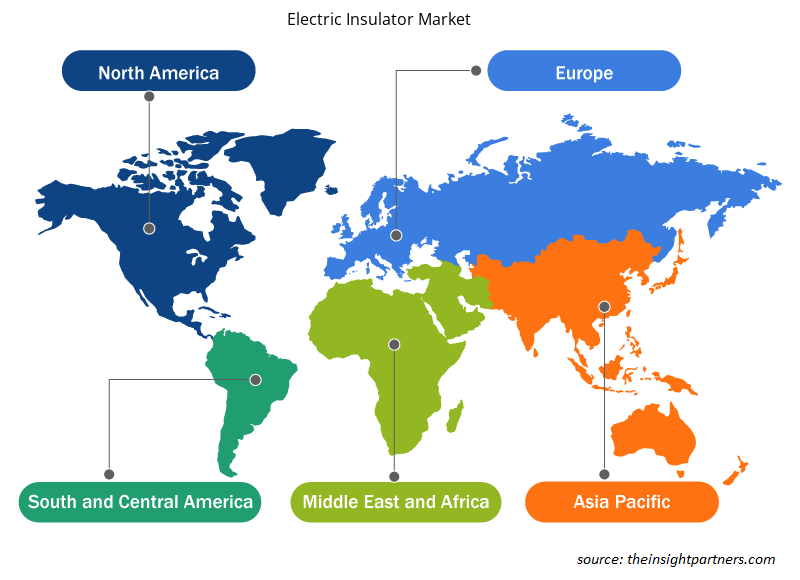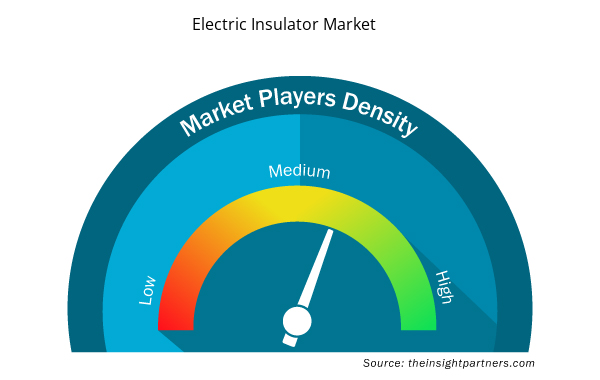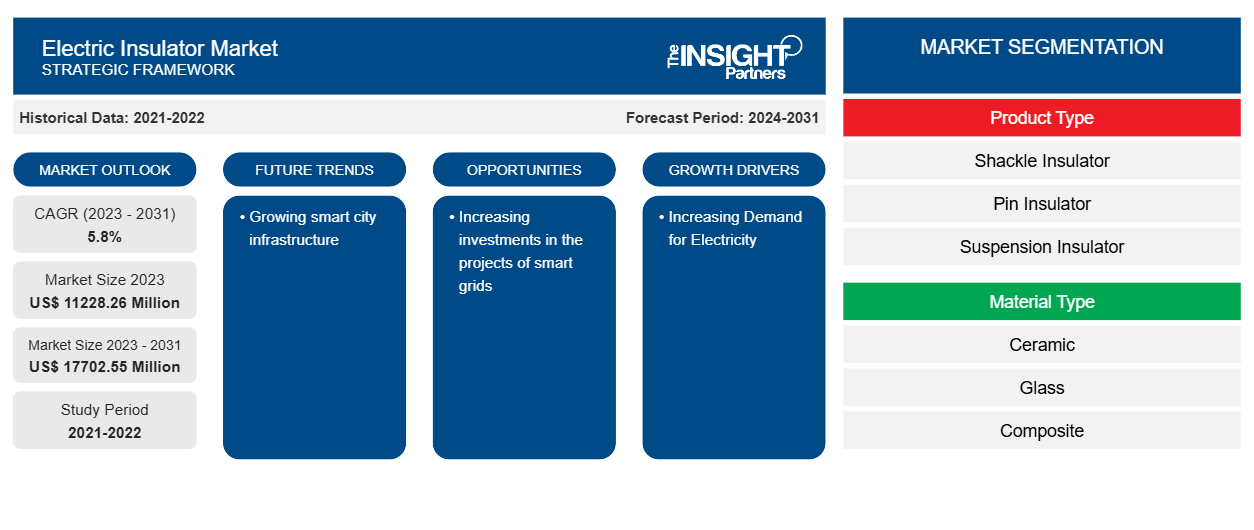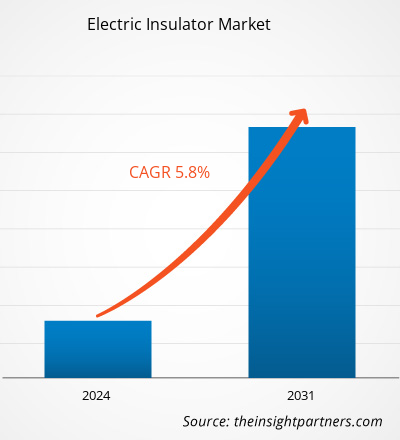Der Markt für elektrische Isolatoren soll von 11.228,26 Millionen US-Dollar im Jahr 2023 auf 17.702,55 Millionen US-Dollar im Jahr 2031 anwachsen. Der Markt wird zwischen 2023 und 2031 voraussichtlich eine durchschnittliche jährliche Wachstumsrate (CAGR) von 5,8 % verzeichnen. Die wachsende Smart-City-Infrastruktur dürfte ein wichtiger Trend auf dem Markt bleiben.
Marktanalyse für elektrische Isolatoren
Viele Entwicklungsländer, darunter Brasilien, Vietnam, Saudi-Arabien, Indien und andere, konzentrieren sich auf die Steigerung ihrer Industrialisierung. Im Rahmen der Initiative „Make in India“ konzentriert sich die indische Regierung auf wachsende Industrien. Es handelt sich um eine bedeutende nationale Initiative der indischen Regierung, die darauf abzielt, die Talententwicklung zu verbessern, Innovationen zu fördern, geistiges Eigentum zu schützen, Investitionen zu erleichtern und die beste Fertigungsinfrastruktur des Landes zu schaffen. Autos, Autokomponenten, Luftfahrt, Biotechnologie, Chemikalien, Bauwesen, Rüstungsproduktion, elektrische Maschinen, elektronische Systeme, Lebensmittelverarbeitung, IT & BPM, Leder, Medien und Unterhaltung, Bergbau, Öl und Gas, Pharmazeutika, Häfen und Schifffahrt, Eisenbahnen, erneuerbare Energien, Straßen und Autobahnen, Raumfahrt, Textilien und Bekleidung, Wärmekraft, Tourismus und Gastgewerbe sowie Wellness gehören zu den 25 Branchen, die im Mittelpunkt des Programms „Made in India“ stehen.
Marktübersicht für elektrische Isolatoren
Elektrische Leiter und elektrische Isolatoren sind nicht dasselbe. Materialien, die den ungehinderten Fluss von Elektrizität durch sie ermöglichen, heißen elektrische Leiter . Ladungen können problemlos durch sie hindurchfließen. Materialien, die dagegen als Isolatoren wirken, verhindern den freien Durchgang elektrischer Ladungen. Die Fähigkeit von Leitern, Elektrizität zu leiten, wird durch eine Eigenschaft namens Leitfähigkeit bestimmt. Wie viel Widerstand ein Isolator dem Elektrizitätsfluss bietet, bestimmt, wie effektiv er ist. Diese Eigenschaft wird im Gegensatz zur Leitfähigkeit als spezifischer Widerstand bezeichnet. Isolatoren werden hauptsächlich in Situationen eingesetzt, in denen der Fluss elektrischer Ladungen gestoppt werden muss. Da diese Materialien nicht über die beweglichen elektrischen Ladungen verfügen, die zur Verteilung von elektrischem Strom erforderlich sind, fungieren sie als effiziente Nichtleiter. Elektrische Isolatoren werden hauptsächlich in elektrischen Geräten eingesetzt. So wird zum Beispiel Isoliermaterial über Stromleitungen gelegt, die Strom durch Häuser leiten, um sie vor möglichen Sicherheitsrisiken zu schützen.
Passen Sie diesen Bericht Ihren Anforderungen an
Sie erhalten kostenlos individuelle Anpassungen an jedem Bericht, einschließlich Teilen dieses Berichts oder einer Analyse auf Länderebene, eines Excel-Datenpakets sowie tolle Angebote und Rabatte für Start-ups und Universitäten.
- Holen Sie sich die wichtigsten Markttrends aus diesem Bericht.Dieses KOSTENLOSE Beispiel umfasst eine Datenanalyse von Markttrends bis hin zu Schätzungen und Prognosen.
Treiber und Chancen auf dem Markt für elektrische Isolatoren
Steigende Nachfrage nach Elektrizität
Der gesamte Stromverbrauch der USA lag im Jahr 2022 laut der US Energy Information Administration bei etwa 4,07 Billionen Kilowattstunden. Die wachsende Bevölkerung braucht mehr Strom. Mit der steigenden Nachfrage nach Elektrizität in gewerblichen, privaten und industriellen Anwendungen werden laut Angaben des Energieministeriums auch mehr Übertragungs- und Verteilungsnetze benötigt, um die Welt mit Strom zu versorgen. In Indien wurde das Stromerzeugungsziel (einschließlich erneuerbarer Energien) für das Jahr 2023-24 auf 1750 Milliarden Einheiten (BU) gesenkt. Dies entspricht einem Wachstum von rund 7,2 % gegenüber einer tatsächlichen Erzeugung von 1624,158 BU im Vorjahr (2022-23). Die Erzeugung im Jahr 2022-23 betrug 1624,158 BU, verglichen mit 1491,859 BU im Jahr 2021-22, was einem Wachstum von etwa 8,87 % entspricht. Daher erhöhen der steigende Strombedarf und die zunehmenden Investitionen in Übertragungs- und Verteilungsnetze den Bedarf an elektrischen Isolatoren.
Steigende Investitionen in Smart Grid-Projekte
Um den unterschiedlichen Energiebedarf der Endverbraucher zu decken, ist ein Smart Grid ein Stromnetz, das digitale und andere Spitzentechnologien nutzt, um den Transport von Strom aus allen Erzeugungsquellen zu überwachen und zu steuern. Die Regierungen verschiedener Regionen investieren erheblich in Smart-Grid-Projekte. So hat das US-Energieministerium (DOE) im Oktober 2023 3,46 Milliarden US-Dollar für 58 Smart-Power-Grid-Projekte in 44 Bundesstaaten bereitgestellt, die darauf abzielen, die Belastbarkeit und Zuverlässigkeit des nationalen Stromnetzes zu stärken. Die Initiativen, die durch das überparteiliche Infrastrukturgesetz unterstützt werden, werden eine Gesamtinvestition von über 8 Milliarden US-Dollar aus staatlichen und privaten Quellen bewirken. Steigende Investitionen in intelligente Stromnetze schaffen also Chancen für den Markt.
Segmentierungsanalyse des Marktberichts für elektrische Isolatoren
Wichtige Segmente, die zur Ableitung der Marktanalyse für elektrische Isolatoren beigetragen haben, sind Produkttyp, Materialtyp, Anwendung und Endbenutzer.
- Basierend auf dem Produkttyp ist der Markt für elektrische Isolatoren in Schäkelisolatoren, Stiftisolatoren , Aufhängungsisolatoren und andere Produkttypen unterteilt. Das Segment der Stiftisolatoren hatte im Jahr 2023 einen größeren Marktanteil.
- Nach Materialtyp ist der Markt in Keramik, Glas und Verbundwerkstoffe segmentiert. Das Keramiksegment hatte im Jahr 2023 einen größeren Marktanteil.
- Nach Anwendung ist der Markt in Transformatoren, Sammelschienen , Kabel, Schaltanlagen , Überspannungsschutzgeräte und andere Anwendungen segmentiert.
Nach Endbenutzer ist der Markt in Versorgungsunternehmen, Industrie und andere Endbenutzer segmentiert.
Marktanteilsanalyse für elektrische Isolatoren nach Geografie
Der geografische Umfang des Marktberichts für elektrische Isolatoren ist hauptsächlich in fünf Regionen unterteilt: Nordamerika, Asien-Pazifik, Europa, Naher Osten und Afrika sowie Süd- und Mittelamerika. APAC dominiert den Markt für elektrische Isolatoren. Der Markt für elektrische Isolatoren in dieser Region wächst aufgrund verschiedener Faktoren, wie z. B. zunehmender staatlicher Initiativen für die Stromnetzinfrastruktur und der wachsenden Bevölkerung sowie der Wirtschaft.
Regionale Einblicke in den Markt für elektrische Isolatoren
Die regionalen Trends und Faktoren, die den Markt für elektrische Isolatoren während des gesamten Prognosezeitraums beeinflussen, wurden von den Analysten von Insight Partners ausführlich erläutert. In diesem Abschnitt werden auch die Marktsegmente und die Geografie für elektrische Isolatoren in Nordamerika, Europa, im asiatisch-pazifischen Raum, im Nahen Osten und Afrika sowie in Süd- und Mittelamerika erörtert.

- Holen Sie sich die regionalen Daten für den Markt für elektrische Isolatoren
Umfang des Marktberichts über elektrische Isolatoren
| Berichtsattribut | Details |
|---|---|
| Marktgröße im Jahr 2023 | 11228,26 Millionen US-Dollar |
| Marktgröße bis 2031 | 17702,55 Millionen US-Dollar |
| Globale CAGR (2023 - 2031) | 5,8 % |
| Historische Daten | 2021-2022 |
| Prognosezeitraum | 2024–2031 |
| Abgedeckte Segmente | Nach Produkttyp
|
| Abgedeckte Regionen und Länder | Nordamerika
|
| Marktführer und wichtige Unternehmensprofile |
|
Marktteilnehmerdichte: Der Einfluss auf die Geschäftsdynamik
Der Markt für elektrische Isolatoren wächst rasant, angetrieben durch die steigende Nachfrage der Endnutzer aufgrund von Faktoren wie sich entwickelnden Verbraucherpräferenzen, technologischen Fortschritten und einem größeren Bewusstsein für die Vorteile des Produkts. Mit steigender Nachfrage erweitern Unternehmen ihr Angebot, entwickeln Innovationen, um die Bedürfnisse der Verbraucher zu erfüllen, und nutzen neue Trends, was das Marktwachstum weiter ankurbelt.
Die Marktteilnehmerdichte bezieht sich auf die Verteilung der Firmen oder Unternehmen, die in einem bestimmten Markt oder einer bestimmten Branche tätig sind. Sie gibt an, wie viele Wettbewerber (Marktteilnehmer) in einem bestimmten Marktraum im Verhältnis zu seiner Größe oder seinem gesamten Marktwert präsent sind.
Die wichtigsten auf dem Markt für elektrische Isolatoren tätigen Unternehmen sind:
- Hitachi ABB Power Grids Group
- Aditya Birla Isolatoren
- Allgemeine Elektrizit?tsgesellschaft
- Hubbell Incorporated Incorporated
- MacLean-Fogg-Unternehmen
- Isolatoren von NGK Insulators
Haftungsausschluss : Die oben aufgeführten Unternehmen sind nicht in einer bestimmten Reihenfolge aufgeführt.

- Überblick über die wichtigsten Akteure auf dem Markt für elektrische Isolatoren
Neuigkeiten und aktuelle Entwicklungen zum Markt für elektrische Isolatoren
Der Markt für elektrische Isolatoren wird durch die Erhebung qualitativer und quantitativer Daten aus Primär- und Sekundärforschung bewertet, die wichtige Unternehmensveröffentlichungen, Verbandsdaten und Datenbanken umfasst. Nachfolgend sind einige der Entwicklungen auf dem Markt für elektrische Isolatoren aufgeführt:
- Avery Dennison Performance Tapes hat die Einführung des neu entwickelten Volt Tough™-Portfolios an Isolierbandlösungen für Elektrofahrzeuge angekündigt. Dieses fortschrittliche Angebot an elektrisch isolierenden, einseitigen Folienbändern wurde entwickelt, um die Herausforderungen der unzureichenden elektrischen Isolierung in EV-Batteriepacks zu bewältigen. (Quelle: Signify, Pressemitteilung, September 2023)
- Der Verband der chinesischen Maschinenindustrie hat in Nanjing eine nationale Produktbewertungssitzung für 12 neue Typen von Verbundisolatoren mit 1000 kV Wechselstrom, ±800 kV und ±500 kV Gleichstrom organisiert, die von der Nanjing Electric Insulator Co., Ltd. unabhängig entwickelt wurden. Nach Einschätzung der Experten hat die umfassende technische Leistung des Produkts das internationale Spitzenniveau ähnlicher Produkte erreicht. (Quelle: Nanjing Electric Insulator Co., Ltd, Pressemitteilung, März 2020)
Marktbericht zu elektrischen Isolatoren – Umfang und Ergebnisse
Der Bericht „Marktgröße und Prognose für elektrische Isolatoren (2021–2031)“ bietet eine detaillierte Analyse des Marktes, die die folgenden Bereiche abdeckt:
- Marktgröße und Prognose für elektrische Isolatoren auf globaler, regionaler und Länderebene für alle wichtigen Marktsegmente, die im Rahmen des Projekts abgedeckt sind
- Markttrends für elektrische Isolatoren sowie Marktdynamik wie Treiber, Einschränkungen und wichtige Chancen
- Detaillierte PEST/Porters Five Forces- und SWOT-Analyse
- Marktanalyse für elektrische Isolatoren, die wichtige Markttrends, globale und regionale Rahmenbedingungen, wichtige Akteure, Vorschriften und aktuelle Marktentwicklungen umfasst
- Branchenlandschaft und Wettbewerbsanalyse, die die Marktkonzentration, Heatmap-Analyse, prominente Akteure und aktuelle Entwicklungen auf dem Markt für elektrische Isolatoren umfasst
- Detaillierte Firmenprofile
- Historische Analyse (2 Jahre), Basisjahr, Prognose (7 Jahre) mit CAGR
- PEST- und SWOT-Analyse
- Marktgröße Wert/Volumen – Global, Regional, Land
- Branche und Wettbewerbsumfeld
- Excel-Datensatz


- Bioremediation Technology and Services Market
- Rare Neurological Disease Treatment Market
- Hair Wig Market
- Radiopharmaceuticals Market
- Customer Care BPO Market
- Volumetric Video Market
- Airport Runway FOD Detection Systems Market
- Medical Devices Market
- Ketogenic Diet Market
- Grant Management Software Market

Report Coverage
Revenue forecast, Company Analysis, Industry landscape, Growth factors, and Trends

Segment Covered
This text is related
to segments covered.

Regional Scope
North America, Europe, Asia Pacific, Middle East & Africa, South & Central America

Country Scope
This text is related
to country scope.
Häufig gestellte Fragen
The expected CAGR of the global electric insulator market is 5.8%.
The global electric insulator market is expected to reach US$ 17702.55 million by 2031.
Growing smart city infrastructure is anticipated to play a significant role in the global electric insulator market in the coming years.
The key players holding majority shares in the global electric insulator market are Hitachi ABB Power Grids Group, Aditya Birla Insulators, General Electric Company, Hubbell Incorporated, MacLean-Fogg Company, NGK Insulators, Ltd., PFISTERER Holding AG, SEVES Group, Siemens AG, and TE Connectivity Ltd.
Increasing demand for electricity and Increasing investments in the projects of smart grids are the major factors that propel the global electric insulator market.
APAC dominates the electric insulator market.
Trends and growth analysis reports related to Electronics and Semiconductor : READ MORE..
The Insight Partners performs research in 4 major stages: Data Collection & Secondary Research, Primary Research, Data Analysis and Data Triangulation & Final Review.
- Data Collection and Secondary Research:
As a market research and consulting firm operating from a decade, we have published and advised several client across the globe. First step for any study will start with an assessment of currently available data and insights from existing reports. Further, historical and current market information is collected from Investor Presentations, Annual Reports, SEC Filings, etc., and other information related to company’s performance and market positioning are gathered from Paid Databases (Factiva, Hoovers, and Reuters) and various other publications available in public domain.
Several associations trade associates, technical forums, institutes, societies and organization are accessed to gain technical as well as market related insights through their publications such as research papers, blogs and press releases related to the studies are referred to get cues about the market. Further, white papers, journals, magazines, and other news articles published in last 3 years are scrutinized and analyzed to understand the current market trends.
- Primary Research:
The primarily interview analysis comprise of data obtained from industry participants interview and answers to survey questions gathered by in-house primary team.
For primary research, interviews are conducted with industry experts/CEOs/Marketing Managers/VPs/Subject Matter Experts from both demand and supply side to get a 360-degree view of the market. The primary team conducts several interviews based on the complexity of the markets to understand the various market trends and dynamics which makes research more credible and precise.
A typical research interview fulfils the following functions:
- Provides first-hand information on the market size, market trends, growth trends, competitive landscape, and outlook
- Validates and strengthens in-house secondary research findings
- Develops the analysis team’s expertise and market understanding
Primary research involves email interactions and telephone interviews for each market, category, segment, and sub-segment across geographies. The participants who typically take part in such a process include, but are not limited to:
- Industry participants: VPs, business development managers, market intelligence managers and national sales managers
- Outside experts: Valuation experts, research analysts and key opinion leaders specializing in the electronics and semiconductor industry.
Below is the breakup of our primary respondents by company, designation, and region:

Once we receive the confirmation from primary research sources or primary respondents, we finalize the base year market estimation and forecast the data as per the macroeconomic and microeconomic factors assessed during data collection.
- Data Analysis:
Once data is validated through both secondary as well as primary respondents, we finalize the market estimations by hypothesis formulation and factor analysis at regional and country level.
- Macro-Economic Factor Analysis:
We analyse macroeconomic indicators such the gross domestic product (GDP), increase in the demand for goods and services across industries, technological advancement, regional economic growth, governmental policies, the influence of COVID-19, PEST analysis, and other aspects. This analysis aids in setting benchmarks for various nations/regions and approximating market splits. Additionally, the general trend of the aforementioned components aid in determining the market's development possibilities.
- Country Level Data:
Various factors that are especially aligned to the country are taken into account to determine the market size for a certain area and country, including the presence of vendors, such as headquarters and offices, the country's GDP, demand patterns, and industry growth. To comprehend the market dynamics for the nation, a number of growth variables, inhibitors, application areas, and current market trends are researched. The aforementioned elements aid in determining the country's overall market's growth potential.
- Company Profile:
The “Table of Contents” is formulated by listing and analyzing more than 25 - 30 companies operating in the market ecosystem across geographies. However, we profile only 10 companies as a standard practice in our syndicate reports. These 10 companies comprise leading, emerging, and regional players. Nonetheless, our analysis is not restricted to the 10 listed companies, we also analyze other companies present in the market to develop a holistic view and understand the prevailing trends. The “Company Profiles” section in the report covers key facts, business description, products & services, financial information, SWOT analysis, and key developments. The financial information presented is extracted from the annual reports and official documents of the publicly listed companies. Upon collecting the information for the sections of respective companies, we verify them via various primary sources and then compile the data in respective company profiles. The company level information helps us in deriving the base number as well as in forecasting the market size.
- Developing Base Number:
Aggregation of sales statistics (2020-2022) and macro-economic factor, and other secondary and primary research insights are utilized to arrive at base number and related market shares for 2022. The data gaps are identified in this step and relevant market data is analyzed, collected from paid primary interviews or databases. On finalizing the base year market size, forecasts are developed on the basis of macro-economic, industry and market growth factors and company level analysis.
- Data Triangulation and Final Review:
The market findings and base year market size calculations are validated from supply as well as demand side. Demand side validations are based on macro-economic factor analysis and benchmarks for respective regions and countries. In case of supply side validations, revenues of major companies are estimated (in case not available) based on industry benchmark, approximate number of employees, product portfolio, and primary interviews revenues are gathered. Further revenue from target product/service segment is assessed to avoid overshooting of market statistics. In case of heavy deviations between supply and demand side values, all thes steps are repeated to achieve synchronization.
We follow an iterative model, wherein we share our research findings with Subject Matter Experts (SME’s) and Key Opinion Leaders (KOLs) until consensus view of the market is not formulated – this model negates any drastic deviation in the opinions of experts. Only validated and universally acceptable research findings are quoted in our reports.
We have important check points that we use to validate our research findings – which we call – data triangulation, where we validate the information, we generate from secondary sources with primary interviews and then we re-validate with our internal data bases and Subject matter experts. This comprehensive model enables us to deliver high quality, reliable data in shortest possible time.


 Holen Sie sich ein kostenloses Muster für diesen Bericht
Holen Sie sich ein kostenloses Muster für diesen Bericht